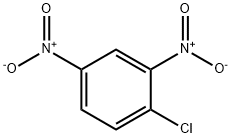
97-00-7
| Name | 2,4-Dinitrochlorobenzene |
| CAS | 97-00-7 |
| EINECS(EC#) | 202-551-4 |
| Molecular Formula | C6H3ClN2O4 |
| MDL Number | MFCD00007075 |
| Molecular Weight | 202.55 |
| MOL File | 97-00-7.mol |
Chemical Properties
| Appearance | yellow crystals with an almond odour |
| Melting point | 48-50 °C(lit.) |
| Boiling point | 315 °C(lit.) |
| bulk density | 760kg/m3 |
| density | 314 |
| vapor density | 6.98 (vs air) |
| vapor pressure | 1 hPa (106 °C) |
| refractive index | 1.5857 |
| Fp | 367 °F |
| storage temp. | Store below +30°C. |
| solubility | alcohol: very slightly soluble (cold)(lit.) |
| form | Crystalline Mass, Chunks or Crystals and Powder |
| color | Yellow to brown |
| Odor | Almond-like |
| Stability: | Stable. Combustible. Incompatible with strong oxidizing agents, ammonia. Reacts violently with hydrazine hydrate. |
| explosive limit | 1.9-22%(V) |
| Water Solubility | insoluble |
| Merck | 14,2136 |
| BRN | 613161 |
Safety Data
| Hazard Codes | T,N |
| Risk Statements | |
| Safety Statements | |
| RIDADR | UN 3441 6.1/PG 2 |
| WGK Germany | 2 |
| RTECS | CZ0525000 |
| Autoignition Temperature | 464 °C |
| Hazard Note | Toxic |
| TSCA | Yes |
| HazardClass | 6.1 |
| PackingGroup | II |
| HS Code | 29049020 |
| Storage Class | 6.1A - Combustible acute toxic Cat. 1 and 2 very toxic hazardous materials |
| Hazard Classifications | Acute Tox. 2 Dermal Acute Tox. 4 Oral Aquatic Acute 1 Aquatic Chronic 1 Eye Dam. 1 Skin Irrit. 2 Skin Sens. 1 |
| Safety Profile | |
| Hazardous Substances Data | 97-00-7(Hazardous Substances Data) |
| Toxicity |